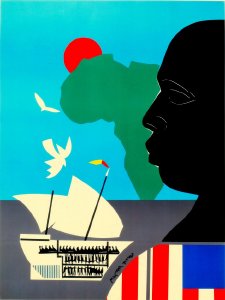ROMARE BEARDEN: VISION AND ACTIVISM examines how an American artist agitated for social change through the power of his art and writing. For over fifty years, Romare Bearden (1911-1988) depicted, defined, and celebrated the life that surrounded him.
"... it is not my aim to paint about the Negro in America in terms of propaganda. It is precisely my awareness of the distortions required of the polemicist that has caused me to paint the life of my people as I know it-as passionately and dispassionately as Brueghel painted the life of the Flemish people of his day."
-Romare Bearden from "Rectangular Structure in My Montage Paintings" (1969)
To say he had a unique perspective and heightened skill at expression, only begins to consider his genius. He lived through tumultuous and exciting times of change in this country. He was involved in political action inside and out of the studio. Whether he worked in text, painting, collage, printmaking, or commissioned publications and murals, he chose to reflect his concerns and experiences in his creations. Because of this, you see in his art references to war, struggle and strife, but also ritual, music, and family.
Vision and Activism traces Bearden's evolution into a true master artist whose art changed people's ways of seeing the world. Through a diverse collection of original collage, watercolor, limited edition prints, reproductions, and archival material, viewers glimpse a vision of reviewing, revising, and celebrating throughout. The exhibition starts with examples of the beginnings of his art exploration with editorial cartoons for university magazines, and later, national publications and newspapers. There are examples where Bearden takes on the past to engender pride, as in Slave Ship where he takes on the story of Cinque who led a mutiny aboard a slave ship. In others, Bearden engages current events, such as the John Lindsay piece for Time Magazine.
Artists often make social change simply through representing, or rearranging the way we see people or things. In a large section the artist explores Visualizing the African American Landscape. Bearden's observations of American life and culture may not seem unique to us now, because of how much they have informed what we now imagine about Mecklenburg County, NC in the early 20th century, or Harlem, NY of the 1950's. We see the prevalence of rituals- people at work, at play, in the home, and in the jazz club- but it's his use of collage, and other artistic techniques, which readjusts our lens of understanding complex lives. In this section are examples of where Bearden Claims the Classics, showing the artist's great love of literature and skill at story telling. Here he revisits and reconstructs themes of bullfighting, the Trojan War, and the Bible, into stories that at once seem both specific and universal.
It's apt to make note of a section of Bearden and Women, as it brings full circle the early influence of the artist's mother, Bessye J. Bearden, a dynamic force in her son's life and to the Harlem community of her time. Generations to come will engage this vision through Bearden's visual conversations that continue to speak to issues relevant today.
Originally curated by Diedra Harris-Kelley, C. Daniel Dawson, and Robert G. O'Meally, as "Artist as Activist" (NYC 2011), this exhibition has been revised and updated for the present tour. Organized by the Romare Bearden Foundation, with generous loans from the Estate of Nanette Bearden, and the DC Moore Gallery, New York; Exhibition Management by Landau Traveling Exhibitions, Los Angeles, CA.
Additional works from the David C. Driskell Center's art collection are also on display as well as letters and photos from the David C. Driskell Papers from the David C. Driskell Center archives.
The David C. Driskell Center is supported in part by a grant from the Maryland State Arts Council and individual donors.

 Romare Bearden : Artist as Activist and Visionary
Romare Bearden : Artist as Activist and Visionary